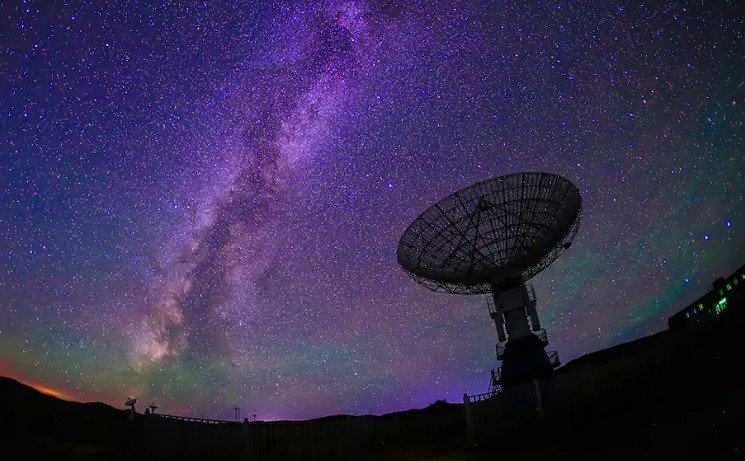The search for extraterrestrial intelligence, or SETI, is one of the most ambitious and fascinating endeavors in science. For decades, astronomers have been scanning the skies for signs of alien civilizations, using radio telescopes and other instruments to look for clues of technology, such as radio transmissions, laser beams, or megastructures. But so far, they have found nothing but silence.
However, SETI is not giving up. It is entering a new era of innovation and exploration, thanks to recent advances in astronomy, technology, and funding. Scientists are developing new methods and tools to expand the scope and sensitivity of their search, as well as to analyze the massive amounts of data they collect. They are also collaborating with other fields of research, such as astrobiology and planetary science, to better understand the potential habitats and behaviors of alien life.

The Breakthrough Listen Project: A Billion-Dollar Boost for SETI
One of the biggest challenges for SETI is the lack of funding and support from the scientific community and the public. SETI has been largely ignored by NASA and other major agencies, and it has relied on private donations and grants to survive. But in 2015, a game-changing announcement was made: Yuri and Julia Milner, a pair of Israeli-Russian billionaires and philanthropists, pledged $100 million to fund a 10-year project called Breakthrough Listen, the most comprehensive and ambitious SETI effort ever undertaken.
Breakthrough Listen aims to survey one million nearby stars, the entire galactic plane, and 100 nearby galaxies using some of the world’s most powerful telescopes, such as the Green Bank Telescope in West Virginia, the Parkes Telescope in Australia, and the MeerKAT Telescope in South Africa. It also plans to cover a wider range of frequencies than previous SETI searches, from radio to optical and infrared wavelengths. The project is expected to generate more than 10 petabytes of data per year, which will be publicly available and analyzed by artificial intelligence and machine learning algorithms.
Breakthrough Listen has already made some significant achievements, such as detecting eight potential signals from nearby stars using AI, discovering dozens of new fast radio bursts, and conducting the first SETI search of the interstellar object ‘Oumuamua. It has also launched several sub-projects, such as:
- BLIPSS (Breakthrough Listen Investigation for Periodic Spectral Signals), which looks for periodic signals that could indicate rotating or orbiting transmitters, such as pulsars or artificial beacons,
- COSMIC (Commensal Open Source Multimode Interferometer Cluster), which is a new instrument installed at the Very Large Array in New Mexico, allows SETI observations to be performed in the background of other astronomical research, covering 80% of the entire sky.
- TESS-SETI, which is a collaboration with NASA’s Transiting Exoplanet Survey Satellite, searches for planets around nearby stars. TESS-SETI aims to look for technosignatures in the same stars that TESS observes, as well as to follow up on any promising exoplanet candidates.
New Search Methods and Targets: Beyond Radio Waves and Sunlike Stars
Another challenge for SETI is the uncertainty and diversity of what they are looking for. There is no guarantee that alien civilizations use radio waves or similar technologies as we do or that they live on planets like Earth around stars like the Sun. Therefore, SETI scientists are exploring new ways and places to detect signs of intelligence, such as:
- Laser SETI, which is a project that uses specialized cameras to scan the entire sky for flashes of laser light that could be used for communication or propulsion by aliens, has installed 8 cameras in 4 locations in the US and plans to expand to more sites around the world.
- METI (Messaging Extraterrestrial Intelligence), which is a controversial approach that involves sending messages to potential alien recipients rather than just listening, proponents of METI argue that this could increase the chances of contact and demonstrate our willingness to communicate. METI opponents warn that this could expose us to unknown risks and ethical dilemmas. METI has conducted several transmissions, such as sending a radio message to a nearby star system in 2017 and encoding a Wikipedia-like database on laser pulses in 2018.
- SETI@home, which is a citizen science project that allows anyone with a computer and an internet connection to participate in SETI by analyzing data from the Arecibo Observatory in Puerto Rico, has been running since 1999 and has attracted millions of volunteers and generated billions of results. However, the project announced in 2020 that it would stop distributing new data as it had reached a point of diminishing returns. The project will continue to analyze the existing data and look for novel ways to engage the public in SETI.
- Exoplanet SETI, which is a growing field that leverages the discoveries and data from exoplanet research, such as the Kepler and TESS missions, to look for signs of intelligence on other worlds, could include looking for anomalies or artifacts in the transit light curves of planets, such as megastructures or artificial illumination, or searching for biosignatures or technosignatures in the spectra of planetary atmospheres, such as pollutants or industrial gases.
The Future of SETI: Challenges and Opportunities
SETI is entering a new era of excitement and optimism as it benefits from the advances and collaborations in astronomy and technology. However, it also faces some challenges and uncertainties, such as:
- The Fermi Paradox, which is the apparent contradiction between the high probability of alien life in the universe and the lack of evidence for it, The Fermi Paradox raises some puzzling questions, such as: Are we alone? Are we the first? Are we the best? Are we the last? Are they hiding? Are they watching? Are they waiting? Are they extinct? There are many possible explanations and solutions for the Fermi paradox, but none of them are conclusive or satisfying.
- The Great Filter, which is a hypothetical barrier that prevents the emergence or survival of intelligent life in the universe, The Great Filter could be a natural or artificial phenomenon, such as a rare evolutionary step, a cosmic catastrophe, self-destruction, or a hostile intervention. The Great Filter could be behind us, which means that we are lucky or special to have overcome it, or ahead of us, which means that we are doomed or endangered to face it.
- The contact scenario is the hypothetical event of detecting or communicating with an alien civilization. The Contact Scenario could have profound implications and consequences for humanity, such as scientific, philosophical, religious, social, political, and cultural impacts. The contact scenario could also pose some risks and challenges, such as misunderstanding, deception, conflict, or dominance. The contact scenario could require some preparation and regulation, such as protocols, policies, and ethics.
Despite these challenges and uncertainties, SETI remains a worthy and noble pursuit, as it could reveal some of the most fundamental truths about ourselves and our place in the cosmos. SETI is not only a scientific endeavor but also a cultural and existential one, as it reflects our curiosity, creativity, and hope. SETI is not only a search for extraterrestrial intelligence but also a search for human significance.






